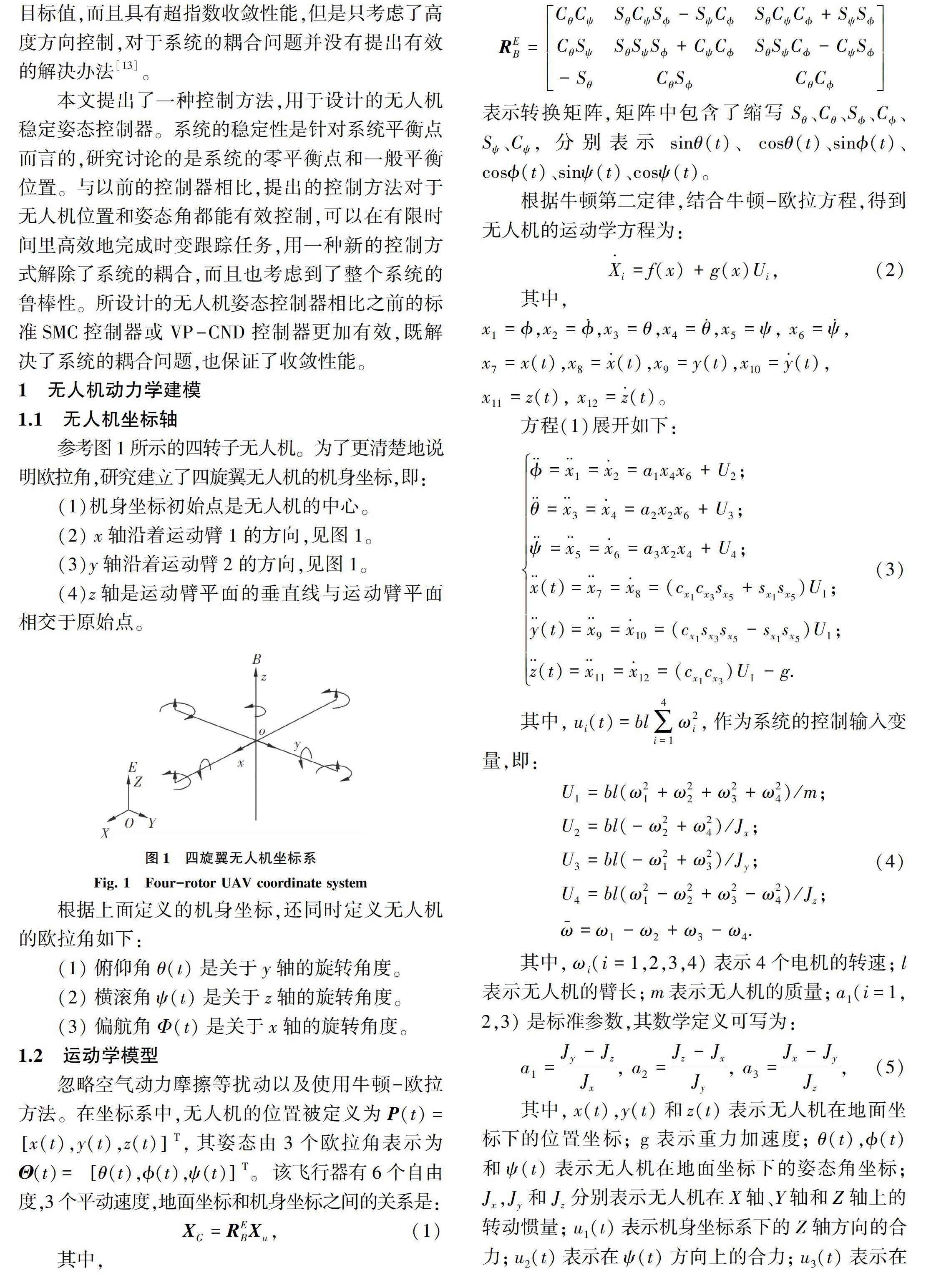基于可变参数滑模控制的四旋翼无人机的姿态控制
望香凝 王朝立 颜飞



摘要:为了稳定控制无人机的位置和姿态角,提出了一种结合滑模控制和状态反馈控制的非线性控制器。本次研究中,建立了四旋翼无人机的运动学模型,提出的一种可变参数的滑模控制和状态反馈控制方法,控制器设计分为2个阶段:设计姿态子系统时变滑模控制器,首先保证3个姿态角的快速收敛性能能满足第二阶段的设计要求;在完成第一阶段控制器的设计的基础上,保证位置姿态三轴上的实时跟踪性能,使得在有限时间里都到达期望的位置。本论文中介绍了现有的标准滑模控制方法和基于齐次系统方法的状态反馈法及相应的控制器,并且进行了对比分析实验。仿真结果表明了所设计的非线性控制器不仅可以有效地跟踪时变目标值,而且收敛性能更好。
关键词: 无人机姿态; 有限时间; 可变参数; 滑模控制; 状态反馈控制
【Abstract】 In order to stably control the position and attitude angle of the drone, a nonlinear controller combining sliding mode control and state feedback control is proposed. In this study, the kinematics model of the quadrotor UAV is established, and a variable parameter sliding mode control and state feedback control method is proposed. The controller design is divided into two stages: the design of the attitude subsystem becomes slippery. The membrane controller first ensures that the fast convergence performance of the three attitude angles can meet the design requirements of the second stage; on the basis of completing the design of the first stage controller, the real-time tracking performance on the three axes of the position and attitude is guaranteed to reach the desired position in a limited time. In this paper, the existing standard sliding mode control method and state feedback method based on homogeneous system method and corresponding controller are introduced, and comparative analysis experiments are carried out. The simulation results show that the designed nonlinear controller can not only effectively track the time-varying target value, but also has better convergence performance.
【Key words】 drone attitude; finite time; variable parameter; sliding mode control; state feedback control
0 引 言
近年來 ,无人机以其低成本、良好的机动性和环境适应能力强等特点, 越来越多地被应用于航拍、测绘、电力巡检、灾害检测、地质勘探等特种行业,多旋翼无人机及其应用目前也引起了越来越多的研究人员的极大兴趣[1-3]。四旋翼无人机可以在任何方向飞行,垂直起飞和降落,并在理想的高度盘旋[4-6]。但也存在着一定的缺点和挑战性,自主飞行控制系统设计的微型无人机对室内和室外环境是具有挑战性的。有研究人员提出了一种新的四转子姿态稳定反馈控制方案,设计了一种飞行控制系统,不仅能稳定姿态,而且能精确地跟踪一个欠驱动的四旋翼飞机的轨迹。在特定的情况下,所提出的控制器被证明是有效的[7-9]。然而,上述所有的工作都局限于姿态轨迹跟踪控制问题,缺乏对位置控制的关注。提出了反馈线性化控制器,发现其对噪声的敏感性和不确定性建模,从而有针对性地提出了滑模控制器,但是,四转子动力学是一个简化的过程,忽略了态度和位置之间的耦合[10];有研究人员提出了一些神经动力学方法(如张动力学(ZD)和梯度动力学(GD)),设计了无人机的位置和姿态角控制器[11-12]。Zhang等人[13]为了稳定地控制无人飞行器(UAV)的位置和姿态角度,提出了一种可变参数收敛神经动力学(VP-CND)方法,可以跟踪时变目标值,而且具有超指数收敛性能,但是只考虑了高度方向控制,对于系统的耦合问题并没有提出有效的解决办法[13]。
本文提出了一种控制方法,用于设计的无人机稳定姿态控制器。系统的稳定性是针对系统平衡点而言的,研究讨论的是系统的零平衡点和一般平衡位置。与以前的控制器相比,提出的控制方法对于无人机位置和姿态角都能有效控制,可以在有限时间里高效地完成时变跟踪任务,用一种新的控制方式解除了系统的耦合,而且也考虑到了整个系统的鲁棒性。所设计的无人机姿态控制器相比之前的标准SMC控制器或VP-CND控制器更加有效,既解决了系统的耦合问题,也保证了收敛性能。
1 無人机动力学建模
1.1 无人机坐标轴
本次研究得到的姿态角收敛误差及速度收敛误差如图2所示,不同p值下的姿态角收敛误差及角速度收敛误差如图3所示。
根据图2、图3可以看出,所设计的可变参数滑模控制器对比标准滑模控制方法,收敛速度更快,可以在2 s以内收敛到目标曲线。并且所设计的控制器性能会随着p值增大而改善,p=5时,收敛速度和误差明显是优于p=2和p=3的。
研究后可得,x(t)、y(t)和z(t)的收敛误差及速度收敛误差曲线具体见图4~6。由图4~图6可以得到,对比基本滑模控制方法,位置姿态控制器所采用的状态反馈控制方法收敛速度是远远快于标准SMC控制器,而且标准滑模控制方法在整个过程中的抖动是比较严重的,状态反馈控制器在稳定到目标值后,抖动明显改善。
4 结束语
本文提出了一种基于变参数滑模动力学方法和状态反馈方法的多旋翼无人机控制方法。通过Lyapunov稳定性理论,给出了整个系统的稳定性分析。仿真对比表明,所设计的控制方法具有较好的鲁棒性和跟踪性能。仿真结果也验证了该方法的有效性。论文提出的控制器能较好地完成时变追踪任务,是与标准滑模控制器相比收敛速度更快、更稳定的控制器。对于未来的工作,仍有如下方面亟待完善:首先,由于该方法是基于无人机的理论模型,所提出的控制器只有在完全状态的测量值可用于反馈以及初值确定的情况下才可实现。在实际操作中,这不是四旋翼飞行器在受控环境之外飞行的典型情况,所以对于应用到实际上还需要做进一步的研究,
参考文献
[1]POKSAWATP, WANG Liuping, MOHAMED A. Gain scheduled attitude control of fixed-wing UAV with automatic controller tuning[J]. IEEE Transactions on Control Systems Technology, 2018,26(4):1192.
[2]BERTRAN E, SNCHEZ-CERD A. On the tradeoff between electrical power consumption and flight performance in fixed-wing UAV autopilots[J]. IEEE Transactions on Vehicular Technology, 2016, 65(11):8832.
[3]MARINA H G D, PEREDA F J, GIRON-SIERRA J M, et al. UAV attitude estimation using unscented Kalman filter and TRIAD[J].IEEE Transactions on Industrial Electronics, 2012,59(11):4465.
[4]TOLEDO J, ACOSTA L,SIGUT M, et al. Stabilization and altitude tracking of a four-rotor microhelicopter using the lifting operators[J]. IET Control Theory and Applications,2009, 3(4):452.
[5]POUNDS P E I, DOLLAR A M. Stability of helicopters in compliant contact under PD-PID control[J]. IEEE Transactions on Robotics, 2014,30(6): 1472.
[6]CHEN Fuyang, LEI Wen, ZHANG Kangkang, et al. A novel nonlinear resilient control for a quadrotor UAV via backstepping control and nonlinear disturbance observer[J]. Nonlinear Dynamics, 2016, 85(2):1281.
[7]LEE D, KIM H J, SASTRY S. Feedback linearization vs. adaptive sliding mode control for a quadrotor helicopter[J]. International Journal of control, Automation and systems, 2009, 7(3):419.
[8]ZUO Zongyu, MALLIKARJUNAN S. L1 adaptive backstepping for robust trajectory tracking of UAVs[J]. IEEE Transactions on Industrial Electronics,2017,64(4):2944.
[9]ZHANG Zhijun, YU Jianli, LI Yuanqing, et al. A new neural-dynamic control method of position and angular stabilization for autonomous quadrotor UAVs[C]//IEEE International Conference on Fuzzy Systems. Vancouver, BC, Canada:IEEE,2016:850.
[10]LIAO Bolin, FANG Ying, ZHANG Yinyan, et al. Spot hover control of helicopter and swing control of helicopter sling load by using zhang-gradient method[C]//2015 34th Chinese Control Conference (CCC).Hangzhou, China:IEEE,2015: 506.
[11]LI Shihua, DING Shihong,TIAN Yuping. A finite-time state feedback stabilization for a class of second order nonlinear systems[J].Acta Automaticav Sinica, 2007,33(1):101.
[12]ZHANG Yunong, YIN Yonghua, WU Huarong, et al. Zhang dynamics and gradient dynamics with tracking-control application[C]//Proceedings of the 2012 Fifth International Symposium on Computational Intelligence and Design - Volume 01. Hangzhou, China:IEEE,2013,1: 235.
[13]ZHANG Zhijun, ZHENG Lunan, GUO Qi. A varying-parameter convergent neural dynamic controller of multi-rotor UAVs for tracking time-varying tasks[J]. IEEE Transactions on Vehicular Technology, 2018,67(6):4793.
[15] WOOLFE A, GOODSON M, GOODE D K, et al. Highly conserved non-coding sequences are associated with vertebrate development[J]. PLoS biology, 2005, 3(1): 116.
[16]PENNACCHIO L A, AHITUV N, MOSES A M, et al. In vivo enhancer analysis of human conserved non-coding sequences[J]. Nature, 2006, 444(7118): 499.
[17]VISEL A, PRABHAKAR S, AKIYAMA J A, et al. Ultraconservation identifies a small subset of extremely constrained developmental enhancers[J]. Nature Genetics, 2008, 40(2): 158.
[18]WASSERMAN W W, FICKETT J W. Identification of regulatory regions which confer muscle-specific gene expression[J]. Journal of Molecular Biology, 1998, 278(1): 167.
[19]CHEN Xi, XU Han, YUAN Ping, et al. Integration of external signaling pathways with the core transcriptional network in embryonic stem cells[J]. Cell, 2008, 133(6): 1106.
[20]ZINZEN R P, GIRARDOT C, GAGNEUR J, et al. Combinatorial binding predicts spatio-temporal cis-regulatory activity[J]. Nature, 2009, 462(7269): 65.
[21]VISEL A, BLOW M J, LI Zirong, et al. ChIP-seq accurately predicts tissue-specific activity of enhancers[J]. Nature, 2009, 457(7231): 854.
[22]MAY D, BLOW M J, KAPLAN T, et al. Large-scale discovery of enhancers from human heart tissue[J]. Nature Genetics, 2011, 44(1): 89.
[23]DORSCHNER M O, HAWRYLYCZ M, HUMBERT R, et al. High-throughput localization of functional elements by quantitative chromatin profiling[J]. Nature Methods, 2004, 1(3): 219.
[24]GIRESI P G, KIM J, MCDANIELL R M, et al. FAIRE (Formaldehyde-Assisted Isolation of Regulatory Elements) isolates active regulatory elements from human chromatin[J]. Genome Research, 2007, 17(6): 877.

